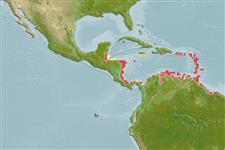Bivalvia |
Cardiida |
Donacidae
Environment: milieu / climate zone / пределы глубины / distribution range
экология
; пределы глубины 0 - 2 m (ссылка 83435). Tropical; 18°N - 6°N, 88°E - 35°E (ссылка 83435)
Western Atlantic: Caribbean and Lower Antilles to northern South America.
Length at first maturity / Size / Weight / Возраст
половая зрелость: Lm ? range ? - ? cm Max length : 4.0 cm NG самец/пол неопределен; (ссылка 83435); common length : 2.5 cm TL самец/пол неопределен; (ссылка 344)
Shell wedge-shaped, inflated. Posterior slope flat or concave, with fine radial threads. Colour: variable, usually cream with purplish or bluish tinges. Umbones usually darker hues.
Habitat: Infaunal in shallow sand, usually in environments rich in particulate organic matter (Ref. 344).
Life cycle and mating behavior
половая зрелость | размножение | нерест | Eggs | Fecundity | Larvae
Members of the class Bivalvia are mostly gonochoric, some are protandric hermaphrodites. Life cycle: Embryos develop into free-swimming trocophore larvae, succeeded by the bivalve veliger, resembling a miniature clam.
Основная ссылка
ссылки | координатор | соавторы
Leal, J.H. 2003 Bivalves. p. 25-98. In Carpenter, K.E. (ed.). The living marine resources of the Western Central Atlantic. Volume 1: Introduction, molluscs, crustaceans, hagfishes, sharks, batoid fishes, and chimaeras. FAO Species Identification Guide for Fishery Purposes and American Society of Ichthyologists and Herpetologists Special Publication No. 5. 1600p. (ссылка 344)
Статус Красного Списка МСОП
(ссылка 130435: Version 2025-1)
Статус СИТЕС (ссылка 108899)
Not Evaluated
CMS (ссылка 116361)
Not Evaluated
Угроза для людей
Harmless
Использование человеком
рыболовство: коммерческий
| FishSource |
инструменты
дополнительная информация
Trophic EcologyFood items (preys)
состав пищи
потребление пищи
хищники
Life cycleразмножениеполовая зрелостьFecundityнерестEggsРазвитие икрыLarvae PhysiologyOxygen consumption
Human RelatedStamps, coins, misc.
ресурсы в Интернет
Estimates based on models
Preferred temperature
(Ref.
115969): 27 - 28.4, mean 27.6 (based on 174 cells).
устойчивость к внешним воздействиям
высокий, минимальное время удвоения популяции до 15 месяцев (K=0.8).
Fishing Vulnerability
Low vulnerability (10 of 100).
